Historic procession of Veteran Locomotives on the Original Stockton and Darlington Line
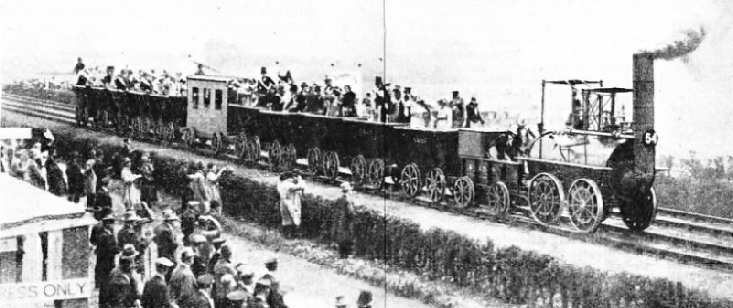
“Locomotion No. 1” hauling a replica train of chaldron wagons with passengers, and the “directors” accommodated in a coach of the company.
EVERY reader knows that the 27th September 1825, was a memorable day in the history of the locomotive, for on that day a train made its first journey on the Stockton and Darlington Railway. To commemorate the hundredth anniversary of this historical event, special celebrations were held in Darlington during the first week in July.
Although, strictly speaking, the anniversary should have been commemorated during the last week in September, there was a good reason for holding the centenary celebrations in July. The International Railway Congress, consisting of represent-atives of the railways of the world, meets every five years. This year the Congress was due to meet in Spain, but in view of the celebration of the centenary of British Railways, the Congress Committee suggested that if the celebrations could be held in July, instead of on the actual date of the anniversary in September, they would hold their 1925 session in London instead of in Madrid. Matters were so arranged and delegates representing the railways of every country journeyed to London, and later to York and to Darlington, where the hundredth birthday of the railway was celebrated on the site of the original Stockton and Darlington Railway.
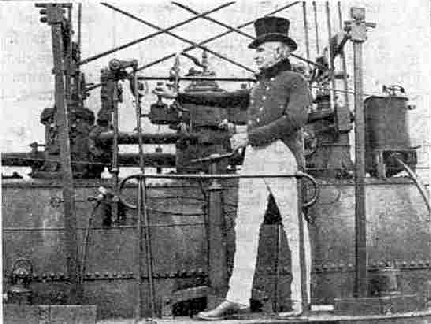
On board the Hetton Colliery Loco. The drivers of early locos were exposed to the weather.
Knowing that readers would be interested in this historic event the Editor made a special journey to Darlington to obtain some photographs of the procession and, more particularly, some first hand details of the veteran locomotives and rolling stock and the other interesting exhibits that were on view at the Faverdale Works of the LNER.
When I arrived in Darlington I found the town “en fete” - the streets were gaily decorated with flags and bunting, the shops were closed, and everyone seemed to be having a holiday in honour of the event. There were special bands and entertainments in the public parks, and everything possible was being done to make the anniversary an event to be remembered - more especially, perhaps, by the boys and girls.
Everywhere one saw evidence of the spirit of the week - in the Park, for instance, was a huge flower-bed designed in the form of a locomotive, with a suitable floral inscription “Centenary: 1825 - 1925”. Almost every shop window was suitably set out - there were locomotives in cardboard, in soap, in chocolate, and even in fruit; old prints dealing with early railways and dozens of books - old and new - on locomotives and railways. Even the hatters and tailors entered into the spirit of the thing and displayed in their windows hats and suits of the period, as worn by the passengers of the trains of a century ago.
The great event of the week was the procession of locomotives and rolling stock, which was to travel over the old railway, from Stockton to Darlington. From a very early hour on the morning of the 2nd July, visitors from all parts of the surrounding district poured into Darlington by train and bus, motor and cycle, and even on foot. Many hours before the procession was due, the streets of the town and the main road between Darlington and Stockton were thick with traffic and the police had s very busy time. Fields along each side of the railway, had been engaged for the occasion, and the spect-ators took advantage of the beautiful weather to make a picnic of the event. In one of the fields there were over 4,000 boys and girls from the Darlington schools and it is estimated that a quarter of a million people lined the edge of the railway between Darlington and Stockton. Every point of vantage was occupied by the spectators - even the roofs of railway coaches that had been shunted on to side lines off the route were used as grandstands - and every bye-lane and field-road was used as a park for the visitors’ cars.
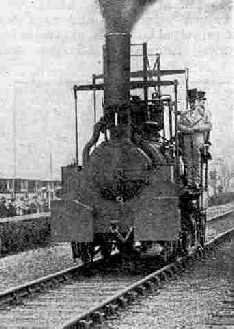
The Hetton Colliery Locomotive (built 1822) which led the procession.
Between the villages of Dinsdale and Urlay Nook, grandstands had been erected for the accommodation of the Royal party and the distinguished visitors, guests of the LNER Company. They were brought to the grandstand by special trains direct from Hull, York, Newcastle and elsewhere. Many thousands of people congregated on the side of the railway opposite the grandstand, and there was great eagerness to see the Duke and Duchess of York, who were paying a special visit to inaugurate the Centenary Celebrations. Their train the progress of which had been reported by telephone and announced to the spectators by loud-speakers, arrived at 10.45 a.m. and the Royal couple were received by Viscount Grey of Falloden, Sir Hugh Bell, and Sir Ralph Wedgewood, the General Manager of the LNER.
There was an interval of ten minutes after the arrival of the Royal party before the head of the eagerly awaited procession came in sight. The first indication we had of its approach was a cloud of black smoke, away down the line towards Stockton. We soon saw that the smoke came from one of the early locomotives, which was slowly approaching. In the distance the overhead mechanism could be seen rising and falling, as the old engine cheerfully “chuffed” along the line at a speed of six miles an hour. It turned out to be the Hetton Colliery engine (0-4-0) built in 1822 by George Stephenson and Nicholas Wood, at Hetton Colliery workshop before Stephenson’s locomotive works at Newcastle-on-Tyne were established. The veteran was rebuilt 1857 and again in 1882, when it was fitted with its present link motion. As it reached the grandstand, this famous old engine, which was in daily use at Hetton Colliery until 1912, was greeted by a loud burst of cheering from the spectators. This tumultous reception seemed to greatly please the driver, who was himself a veteran of the railway and was attired in the dress of a century ago, for he beamed on the spectators with conscious pride.
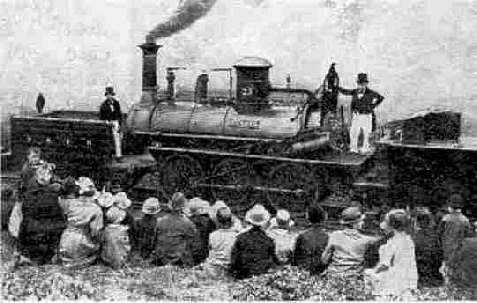
“The Derwent” (1845) with driver and fireman in the “uniform” of the period. Note that the firebox is at the front of the loco.
The next to appear was the “Derwent” (0-6-0), a typical mineral engine, designed by Timothy Hackworth and built in 1845 by Wm. and Alf. Kitching at the Hopetown Foundry, Darlington. It served the Stockton and Darlington Railway for many years before it was sold to Peases’ West Collieries at Crook. After doing good service there it was “retired” and stood, with the famous “Locomotion No. 1”, on a pedestal in Darlington station, where, no doubt, many of our readers have seen it when they have passed through by train. The “Derwent” was driven by George Danby, and be he and his fireman were attired in white trousers, frock coats, and tall hats, as worn in the time of Stephensons.
Following the “Derwent” came a number of goods and mineral train engines, illustrating various types and including LNER No. 10114 (0-6-0) goods engine built by Neilson & Co, of Glasgow in 1868, for the North British Railway. LNER No. 1275 (0-6-0), built in 1874 for the Stockton and Darlington Railway. LNER No. 517 (0-6-0) built in 1905 at Gateshead for the North Eastern Railway. LNER No. 934 (4-6-0) a 3-cylinder express goods loco, built at Darlington in 1921. LNER No. 203 (2-6-0) also a 3-cylinder express goods loco built at Darlington in 1925, and fitted with Gresley’s patent valve-gear. LMS No. 1881 (0-8-0) a 4-cylinder compound mineral loco, built by the London & North Western Railway at Crewe in 1901. LMS No. 9446 (0-8-0) also built at Crewe in 1922. LNER No. 3499 (2-8-0) 3-cylinder mineral loco, built at Doncaster and fitted with Gresley’s patent valve-gear, which loco represented a class of engine used for hauling mineral trams from the northern coal fields to the London area. GWR No. 4700 (2-8-0) loco, built at Swindon in 1919 and used for hauling express goods and heavy excursion trains over the GWR main lines.
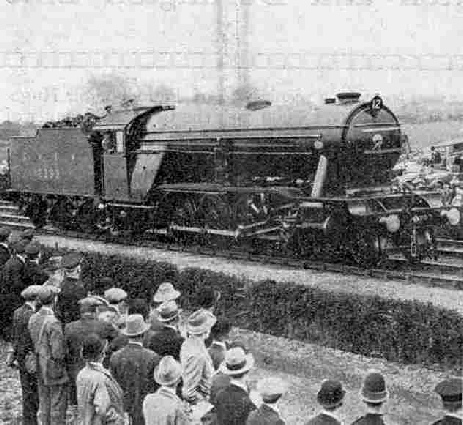 Then came a particularly interesting loco, LNER No. 2393 (2-8-2) the new type 3-cylinder “Mikado”, the first of its class and built at Doncaster this year. This “Mikado” loco has been designed for working heavy coal trains between Peterborough and London, which load up to 100 trucks weighing approximately 1,600 tons. The trains run to a fast schedule in order not to delay the East Coast route and other LNER main line expresses. There are three cylinders each 20-in diameter by 26-in stroke, and actuated by Walschaerts valve gear and driving on to eight coupled wheels 5 ft 3-in in diameter. The forepart of the loco is carried on a pony-truck with 3 ft 2-in diameter wheels. The coupled wheels are spaced under the boiler, and behind them is a second pair of small wheels 3 ft 8-in diameter, but in addition to carrying the footplate end of the loco this latter axle is actually a second engine unit, or “Booster”. The booster-axle is driven by two small cylinders each 10-in in diameter by 12-in stroke, placed below the footplate. The addition of the booster engine increases the tractive power of the loco from 38,500 lb to 47,000 lb and thus makes it nominally the most powerful loco in the country, with the exception of the new “Garratt” loco, to be mentioned later. The boiler of No. 2393 in of large size and is of the type fitted to Mr. H. N. Gresley’s “Pacifies”, while the various other fittings of the loco are of the design now being made standard for the heavy locos of the LNER. The loco was coupled to a large six-wheeled tender of the new standard type to carry 7 tons of coal and 4,700 gallons of water. The loco is fitted with both vacuum and Westinghouse brake system and its maximum weight in full working order is 100 tons, the tender alone weighing 51½ tons.
Then came a particularly interesting loco, LNER No. 2393 (2-8-2) the new type 3-cylinder “Mikado”, the first of its class and built at Doncaster this year. This “Mikado” loco has been designed for working heavy coal trains between Peterborough and London, which load up to 100 trucks weighing approximately 1,600 tons. The trains run to a fast schedule in order not to delay the East Coast route and other LNER main line expresses. There are three cylinders each 20-in diameter by 26-in stroke, and actuated by Walschaerts valve gear and driving on to eight coupled wheels 5 ft 3-in in diameter. The forepart of the loco is carried on a pony-truck with 3 ft 2-in diameter wheels. The coupled wheels are spaced under the boiler, and behind them is a second pair of small wheels 3 ft 8-in diameter, but in addition to carrying the footplate end of the loco this latter axle is actually a second engine unit, or “Booster”. The booster-axle is driven by two small cylinders each 10-in in diameter by 12-in stroke, placed below the footplate. The addition of the booster engine increases the tractive power of the loco from 38,500 lb to 47,000 lb and thus makes it nominally the most powerful loco in the country, with the exception of the new “Garratt” loco, to be mentioned later. The boiler of No. 2393 in of large size and is of the type fitted to Mr. H. N. Gresley’s “Pacifies”, while the various other fittings of the loco are of the design now being made standard for the heavy locos of the LNER. The loco was coupled to a large six-wheeled tender of the new standard type to carry 7 tons of coal and 4,700 gallons of water. The loco is fitted with both vacuum and Westinghouse brake system and its maximum weight in full working order is 100 tons, the tender alone weighing 51½ tons.
The next exhibit was a LNER Electric Freight loco (0-4-4-0) built in 1914 at Darlington for hauling freight trains over the Shildon-Newport electrified section of the LNER. This loco is fitted with four motors, the power being transmitted through spur-gearing to wheels 4 ft in diameter.
A burst of cheering greeted the appearance of a full sized model of the famous “North Star” (2-2-2) built in 1837 by Robert Stephenson & Co. This veteran was mounted on a crocodile wagon and drawn by the small tank engine E. 1. The original “North Star” was intended for a foreign railway, the gauge of which was 6 ft, but subsequently it was altered to suit I. K. Brunel’s 7 ft gauge of the GWR. The “North Star” was taken over by that Company and remained in traffic until 1870.
Then there came four examples of the Single Driver Express Engines so popular in the latter half of the last century, including the LMS “Cornwall” (2-2-2) built at Crewe by the London & North Western Railway to the design of Trevithick’s son, Francis. The principal feature of the “Cornwall” is the huge driving wheels, 8 ft 6-in in diameter and the largest loco driving
wheels in the world. As originally built the “Cornwall” had its boiler underneath the driving axle and was thus shown at the Great Exhibition in London in 1851.
Next we saw LNER No. 910 (2-4-0) built in 1875 at Gateshead, an Express Passenger loco of a type used for working the principal trains between Newcastle and Edinburgh and also between Edinburgh and York. This loco took part in the Newark Brake Trials of 1875 and was also included in the Jubilee celebrations of the Stockton and Darlington Railway in the same year.
Eleven express passenger engines followed, illustrating in a most interesting manner the different classes and their develop-ment. It was fine to see among these exhibits some of the famous locos about which we have all read at some time or another. Those I particularly noticed, for instance, LNER No. 8900, “Lord Claud Hamilton” (4-4-0) built in 1900 by the Great Eastern Railway and well-known to travellers between London (Liverpool Street), Harwich, Ipswich, and Cromer. LNER No. 3990 (4-4 2), an Express Passenger loco built at Doncaster by the Great Northern Railway in 1898 for hauling the East Coast expresses between York and London, and well known as being the first of the “Atlantics” in this country. LNER No. 9902 “Highland Chief” (4-4-2) built for the North British Railway in 1911 for the East Coast route and used for hauling expresses between Glasgow, Edinburgh and Aberdeen. LNER No. 6169 “Lord Farringdon” (4-6-0) a 4-cylinder Express Passenger loco built by the Great Central Railway, and used between Marylebone and Manchester.
Then came an old friend, behind whom I have often travelled - LMS No. 5900, “Sir Gilbert Claughton” (4-6-0) built in 1913 by the London and North Western Railway at Crewe - a 4-cylinder Express Passenger loco used for hauling the principal expresses between Euston, Crewe and Carlisle. She was followed by the famous LNER “Pacific” No. 2563 “William Whitelaw” (4-6-2) a 3-cylinder Express Passenger loco built last year by the North British Loco Co. at Glasgow, fitted with Gresley’s patent valve-gear and used for hauling the principal LNER expresses between London, Edinburgh, Glasgow and Aberdeen. Particulars of this engine are:- cylinders 20-in in diameter and 26-in stroke; driving wheels 6 ft 8-in in diameter; boiler 6 ft 5-in diameter, 19 ft in length; grate area 41.25 sq ft; heating surface 3,455 sq ft; boiler pressure 180 lbs per sq in; tractive effort 29,835 lbs.
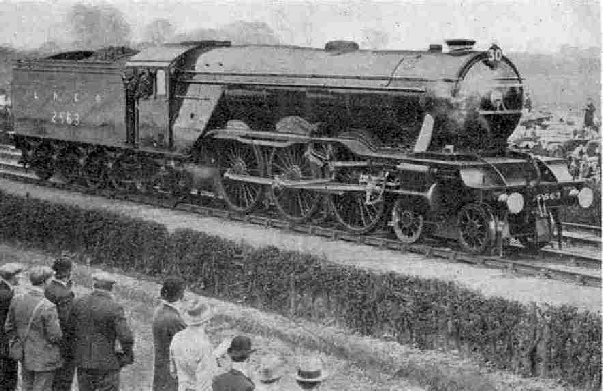
LNER No. 2563 “William Whitelaw” (4-6-2).
Another Electric loco now came into view. This was LNER No. 13 (4-6-4) a Passenger loco built at Darlington in 1922 and originally intended for use on the main line of the North Eastern Railway between Newcastle and York. No. 13 has again proved an unlucky number, for the electrification of the line has not yet been carried out and so the loco is “out of work”. She is equipped with three motors with twin armatures and transmitting power through spur-gearing and quill-drive to wheels 6 ft 8-in in diameter. Following this came No. 66 “Aerolite” (2-2-4) a compound loco built in Leeds in 1851, and 407B a Great Central Saddle-Tank Shunting loco (0-6-0) built in 1876.
A burst of laughter and cheering greeted the next exhibit, which for all the world resembled a cross between a bathing machine and a guard’s van! Trundling along quite merrily to the accompaniment of a clanging bell, it turned out to be No. 7133 (0-4-0), a shunting engine built by the Great Eastern Railway in 1897. The type was first introduced in 1883 and is used chiefly for shunting and working trains on public highways, docks, and quaysides. Six Tank locos followed, including No. 11112 a LMS “Baltic” (4-6-4).
The next exhibit - the new “Garratt” Articulated loco (2-8-0 : 0-8 2) - filled me with delight and was the finest piece of mechanism I had seen for many a long day. Built by Messrs. Beyer, Peacock & Co. Ltd, of Manchester, this huge monster was only delivered to the LNER during the previous week. It is fitted with Gresley’s Valve-gear, and is the most powerful “Garratt” yet constructed for any part of the world and also the heaviest. The type does not need any description, but it certainly did thrill me to see this wonderful example slowly gliding along the line, looking so full of power. Its hauling power is claimed to be equal to two of the 3-cylinder eight-wheels-coupled locos of the 3499 class and where possible the loco details are interchangeable with that class. As this “Garratt” has two sets of three cylinders, it is the first six-cylinder loco to be constructed. To supply the necessary steam to the six cylinders requires a boiler of no less than 7 ft in diameter, this being a much larger boiler than any in service - or even possible - in the ordinary type of loco.
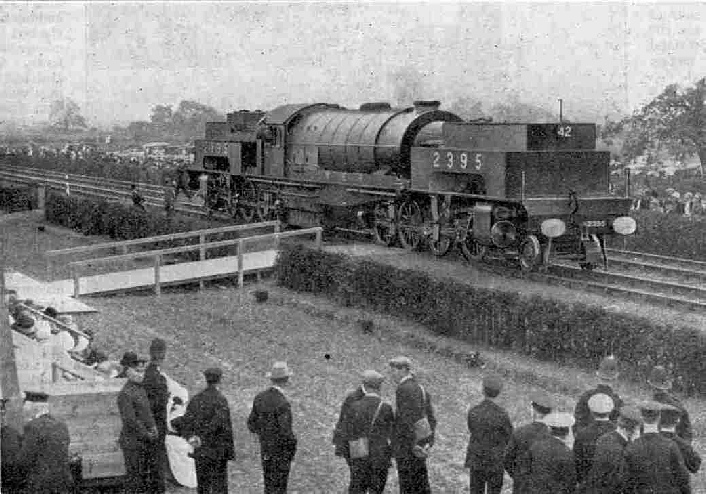
LNER No. 2395, the huge Garratt Articulated loco (2-8 0 + 0-8-2).
Quite a contrast to the previous part of the procession was provided by the next three exhibits - Petrol Bus No. 130 built by the North East Railway in 1922 - really a road vehicle converted for rail service - with accommodation for 26 passengers and driving controls at each end; Petrol Auto Car No. 2105, built in 1923 for the LNER, with a bogie at one end and a single pair of wheels at the other, accommodation for 40 passengers and equipped with electric light and Westinghouse brakes; and a Sentinel Cammell Coach - a handsome steam-motor rail-coach mounted on bogies, accommodation for 60 passengers, of all-steel construction and with boiler and engine carried at one end over the bogie, the ultimate drive being by chains.
Then followed a LNER mineral train composed of 10½, 20 and 40-ton self-discharging wagons, illustrating the gradual development of the high capacity wagons for mineral traffic. The train was drawn by engine No. 904 (0-8-0) a 3-cylinder eight-wheels-coupled, built at Darlington in 1919 and used for hauling heavy trains.
A pleasing change to the long procession of locos was the Tableaux Train illustrating the history of the wheel in transport. The train was drawn by engine No. 130 (0-8-0) an eight-wheels-coupled mineral loco built at Gateshead in 1902. This was one of the 50 locos of this type used in France during the War and its honourable war service was recognised by the chevrons it carried.
The tableaux consisted of six wagons each carrying a separate “picture”. The first was allegorical and depicted a number of astrologers grouped at one side of a symbolic wheel, with a scene showing modern engineering practice on the other. The two scenes were joined through the spokes of the wheel by a huge chain, representing the links of time. The second tableau showed a tribe of prehistoric men, who, having felled a tree with their flint axes, were shown transporting the trunk on logs used as rollers - the earliest form of the wheel. Then came an Egyptian scene in which one of the royal Pharaohs was being drawn on a wheeled platform by slaves, showing how the Egyptians started the wheel in its manifold forms so that, through the ages that followed, progress successively moved on the wheels of chariot, wain, and coach. This was followed by the fourth tableaux showing how the wheel was discarded for a time when Sedan chairs were used, and the fifth depicting the story of the wheel in transport opening its most famous chapter when Stephenson mounted an engine on wheels and steam locomotion began. On one side of this wagon Stephenson was explaining the working of a model of “Locomotion No. 1” to a group of friends and workmen, whilst on the other side modem mechanics were working with present-day materials and tools. The final tableau showed how the railways of the world have grown from the few miles of permanent way uniting Stockton and Darlington.
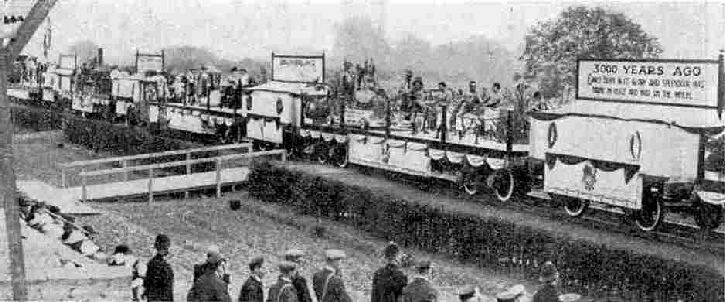
The Tableaux Train passing the Grandstand.
The Tableaux Train was followed by a train of old four-wheeled carriages built in 1865, formerly used on the Great North of Scotland Railway, and drawn by engine No. 45A (4-4-0) built by Neilson & Co, of Glasgow in 1885. In striking contrast to this were the next five exhibits - splendid modem trains, cleaned and polished and looking their best. A LMS Vestibuled-Train of nine vehicles used on the West Coast to Scotland route and drawn by engine 10474 (4-6-0), a 4-cylinder Express Passenger loco built at Harwich by the LMS to the design of Mr. Hughes, their Chief Mechanical Engineer. This was followed by the Royal Train, drawn by GW No. 4082 “Windsor Castle” (4-6-0), a 4-cylinder Express Passenger engine, built at Swindon by the GWR and driven on one occasion by the King with the Queen on the footplate.
Next came a fine example of an articulated train, built at Swindon by the GWR and. used on that Company’s service between London and Plymouth. This train was drawn by the famous GW. 4-cylinder engine No. 111 (4-6-0) originally of the “Pacific” type, built in 1908 and named “The Great Bear”, but rebuilt at Swindon last year to conform to the “Castle” class and re-named “Viscount Churchill”. Then came a Southern Railway train, drawn by a 4-6-0 “King Arthur” express passenger engine. Finally, the “Flying Scotsman” came into sight - a vestibuled train, with triplet-articulated Dining Car and electrically-equipped Kitchen, as used on the East Coast Route to Scotland. The train was hauled by the magnificent “Pacific” No. 2400 “City of Newcastle” (4 6-2) a 3-cylinder passenger loco, built at Darlington in 1922 and typical of the class of loco used for hauling the heavy East Coast expresses between York, Newcastle, and Edinburgh.
The last exhibit in this wonderful railway pageant was, perhaps, the most eagerly awaited by the spectators. It was “Locomotion No. 1” the original engine that drew the first train over the Stockton and Darlington Railway on the 27th September 1825. Someone humorously suggested that it had been arranged for the “Locomotion” to bring up the rear of the procession because it was by no means certain that it would not break down! If this was the reason that the famous old engine came last, the fears of the authorities were groundless, for the “Locomotion”,' hauling a replica of the original train that made the same journey one hundred years ago, ran as well as it did on that memorable occasion, with its overhead mechanism rhythmically rising and falling.
One could well imagine the scene a century ago, and indeed everything possible had been done to make the resemblance as realistic as possible. On that memorable occasion in 1825 the train was made up of chaldron wagons, as the coal wagons of the period were called, and a man on horseback rode in front. The train carried many passengers and also a band, and the directors of the Stockton, and Darlington Railway travelled in the only coach in existence, which was specially described as “the long coach belonging to the Company”.
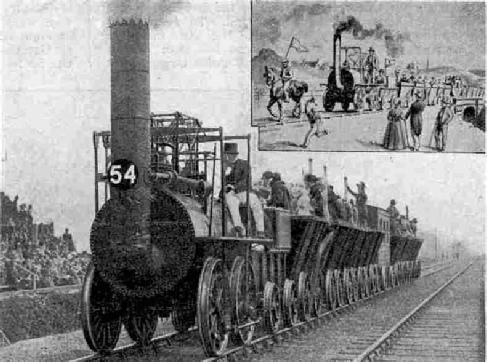
“Locomotion No. 1” and Replica Train. Inset: an old drawing of the same engine and train as it appeared on the opening day of the Stockton & Darlington Railway.
In the centenary procession the train was preceded by a man on horseback with a red flag, and the replicas of the chaldron wagons and the directors’ coach were filled with passengers attired in the same style of dresses as was worn by the original passengers a century ago. The men wore frock-coats and tall beaver hats, and had side whiskers and wigs. The ladies wore sun-bonnets, and skirts with flounces and ribbons, as worn by their great grandmothers on the opening day. The band were accommodated in two of the wagons near the engine, and while the conductor in a white wig proudly wielded his baton, the gaily uniformed bandsmen played the same tunes as were played a century ago.
It had been arranged that the train should stop for a few moments near the grandstand and that the band should provide a musical interlude. As the old “Locomotion” drew near, emitting clouds of black smoke from its tall funnel and covering the be-ribboned lady passengers with soot and dirt, it came to such a sudden, halt that the wagons clashed together and the occupants were thrown violently forward. They clutched wildly at each other in a vain endeavour to support themselves, and even the “Directors” in “the long coach belonging to the Company” looked extremely alarmed as they were jostled to one end of the coach in a confused heap. Sorting themselves out, however, the bandsmen collected enough breath to strike up “Auld Lang Syne”, which was rendered to the accompaniment of tumultuous and prolonged cheering. As the strains of the famous old tune rang out, the Duke and Duchess and the other guests rose to their feet and heads were bared until the veteran engine departed. As the train disappeared round a bend on its way to Darlington the band struck up the famous old north country hunting song, “John Peel”, and although the engine jerked so that the bandsmen were in imminent danger of repeating their earlier experience, their departure from the grandstand was as triumphant as their approach and the strains of old English airs floated down the line, even for a long time after the be-wigged musicians had disappeared from view!
After the procession had passed, Viscount Grey presented the Duke of York with a silver replica of “Locomotion No. 1” and tender, and the Duchess with a silver replica of the historical Stockton and Darlington passenger carriage. The Royal pair then proceeded through dense crowds of cheering spectators to Stockton, where they and over 300 guests were enter-tained to lunch. The Mayor, in proposing the health of the Royal visitors, said:- “You meet us in celebrating the enterprise of a past age and in celebrating the achievements of George Stephenson, Timothy Hackworth and Edward Pease - to name only three of those who were responsible for the first public railway using steam locomotion. You encourage their successors to probe still further into the wonders of transport engineering and science.”
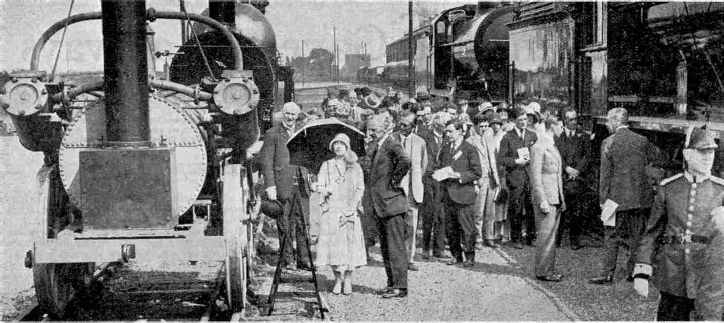
The Duke and Duchess of York inspect the exhibits at the Faverdale Works, Darlington. The “Invicta” (0-4-0) built for the Canterbury & Whitstable Railway, 1830, is seen on the left, and “Coppernob” (2-2-2, built 1846), a loco with a huge copper dome-like firebox, is immediately behind.
The Duke, in returning thanks for the kind welcome extended told a humorous story that evoked great laughter. “We all fully appreciate that no small amount of courage was required to face the oppositions that the opening of the Stockton and Darlington Railway evoked,” he said. “I understand that there was at least one doleful prophet who made the rash offer to eat all the coal the railway would carry! Had that prophet lived in 1923, he would have had to have eaten 217 million tons of coal!”
After lunch, the Duke and Duchess of York proceeded to St. John’s Crossing, Stockton, where they unveiled a tablet on the building from which the first railway ticket was issued. The tablet bears the inscription, “Here the Stockton and Darlington Railway Company issued the first passenger railway ticket thus marking an epoch in the history of mankind”.
Returning to Darlington, I paid a visit to the Faverdale Works of the LNER where a great collection of railway relics was on exhibition. Here were objects that would delight the heart of every reader - pictures and prints, documents and books regarding the early railways; early forms of signalling apparatus; permanent way materials - early railway lines, points, stone sleepers, etc, - models of locos; early railway carriages, and hundreds other things of equal interest. On the sidings outside the Exhibition buildings were the locomotives and rolling stock that had taken part in the morning’s procession. Although the public were not allowed amongst the locos until the following day it was only necessary for me to whisper the magic words “Meccano Magazine” to the friendly policeman on guard to enable me to pass the closely guarded barriers and inspect the veteran locos at my leisure. Here I closely examined with great interest the “Meteorite”, “Hetton”, “Invicta”, “Baltic Tank”, “Garratt” - and dozens of others.
It was here, too, that I was fortunate enough have a few minutes’ chat with Mr. W. Smith, the driver of “Locomotion No. 1” who had just brought his charge to a stand in the sidings, fresh from its triumphant progress in the procession. In reply to my enquiry as to how she ran, he said:- “She is a steady old thing but bumps a bit over points. But what can expect with springs like they made in those days!” “Yes,” he continued, “I have been with the Railway Company for 51 years, so that you can almost say I have seen the modern locomotive grow up.” With this claim I could not but agree!
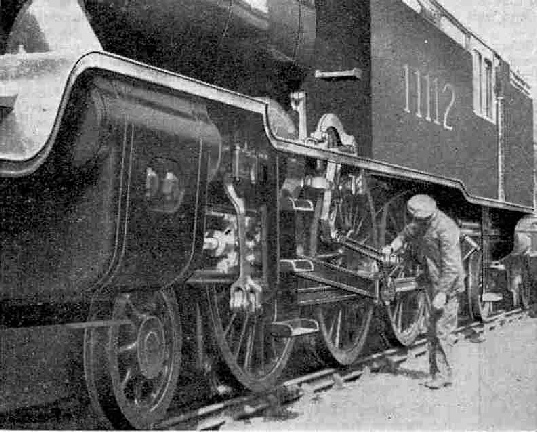
LMS 4-6-4 Baltic Tank No. 11112 on view in the sidings at the Faverdale Exhibition.
“What do you think of my coat, Sir?” I was bound to admit that Mr. Smith’s tail-coat and top hat was a pleasing change from the usual “uniform” of drivers to-day. On the other hand, as Mr. Smith agreed with a hearty laugh, it would indeed cause much merriment to see “Flying Scotsman” travelling along 70 miles per hour with a driver and fireman in top hats and tail coats!
“I am not so sure about this shirt front,” said my friend pointing to the dickie he was wearing. “It is a bit uncomfortable and I was so hot at one time that I nearly took it off, but I remembered I had not passed the grandstand!”
Thus ended my visit to Darlington, and I returned to Liverpool with only one regret - that I was not able to share my pleasure and interest with every reader.
You can read more on “London’s First Railways”, “The Romance of the LNER”, “The Story of the Locomotive”, and “When Railways Were New” on this website.







 Then came a particularly interesting loco, LNER No. 2393 (2-
Then came a particularly interesting loco, LNER No. 2393 (2-




